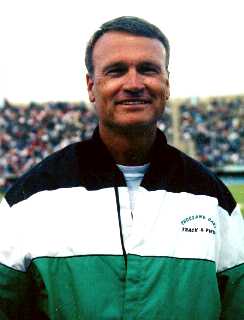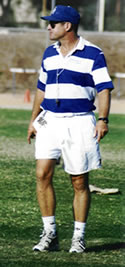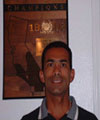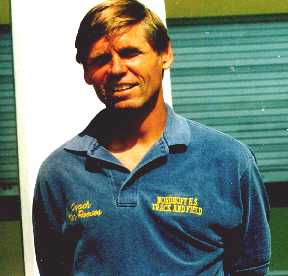 Early-In-The-Season Training
Early-In-The-Season Training
Article By: Jack Farrell
 Training
Ideas
Training
Ideas
Article By: Jack Farrell
Many of the ideas I promote in training actually come from the
observation of adult runners, many of whom are self-coached and
have achieved significant success using prolonged periods of steady-state
running. I also looked at the training schedules of professional
road racers, those who need to run 28 minutes for a 10k, week-in
and week-out, pretty much the whole year, with only an occasional
half-marathon thrown in. Their training is pretty much the same
year round. Only in runners who have defined seasons, as in track
races in the summer and cross country in the fall, followed by
some road races in the winter and spring, will you find periodizing
in their training.
Pool Workouts For Runners
Article By Erin Sloan: M.Ed
Many
athletes today are extolling the virtues and benefits of swim
training. They are making the discovery that, done safely and
with serious intent, there is no downside to cross training in
the pool. This is a phenomenon that surfaces from time to time
on a variety of levels, and history is replete with examples of
champion athletes that have supplemented their training with swimming
(ala "Rocky II") or have made the conversion from competitive
swimming to other sports with some success.
 Preparation
For The Big Meet
Preparation
For The Big Meet
Article By: Jack Farrell
Thousand Oaks High School has run well just often enough at the
end of the season to gain a reputation for peaking. Coaches have
asked me on occasion if there is anything special that we do,
perhaps some secret, which allows us to perform at our best in
the big meets. I never know if I'm quite believed when I say that
we don't do anything special. If there is a secret, that's it.
 Thousand
Oaks Cross Country Training Program
Thousand
Oaks Cross Country Training Program
Article By: Jack Farrell
LATE SEASON
TRAINING
General
Philosophy During This Time
1. What are you trying
to accomplish? Our training is fairly consistent year-round for
our veteran runners. There is not a great deal of difference in
a training run on September 15thand November 15th. We do not follow
a hard-easy pattern. All of our runs are basically tempo runs,
fast, but within the comfort zone. Our mileage increases slightly
from early season to mid-season (from 49 to 56 miles per week
[from 7 to 8 miles per day]), and the pace gradually quickens
as runners become fitter, but the effort is fairly consistent.
Our goals is to lower the comfort zone of our steady state runs.
Athletes gradually dropping from 7 minutes per mile to 6 minutes
per mile will correspondingly drop their race pace 30 to 45 seconds
or more per mile.
 Building
A Successful Cross Country Program
Building
A Successful Cross Country Program
Article By: Tim Butler
Before we
discuss how to develop a successful
cross country program, we need to determine what success
is. Some might define success as winning or beating your opponents.
However, the talent you receive will usually determine that. We
are not always blessed with talent every year. So how can you,
as a coach, be "successful" year-in and year-out?
 Jackrabbits
Discover Signal Hill Gold
Jackrabbits
Discover Signal Hill Gold
Article By: George Wright
While running up to the Poop out hill viewpoint during the 2000
CIF Championship, I was asked by a fellow coach, "How do you train
for a course like this?" My quick reply on the run was, "we run
hills." Not a very helpful answer. I'll try to do better this
time.
Training For The Championships
Article By: Sal Perez
Don Bosco, Rosemead, CA Preparing a cross country training
program that will be competitive in Southern California and hopefully
at the championship level in November, takes months of planning
and organization.
Cross Country Training
Program
Article By: Bill Miller
We like to break the
season into three parts: summer, season, and peaking. Nothing
is etched in stone, and workouts are sometimes based on where
the athletes are and where they need to be. Our workouts are based
on distance, speed and hill training, with equal emphasis put
on each.
 Esperanza Cross Country
Program
Esperanza Cross Country
Program
Article By Rich Medellin: Esperanza High School
At Esperanza, we start
with an aerobic base building mileage phase in the early part
of the season and slowly progress into peak shape by use of aerobic
threshold runs, tempo runs and anaerobic intervals.
Speed Endurance for Cross Country
Article By Jeff Arbogast: Bingham High School
Throughout the modern
era of organized workouts for distance running we see time and
time again the inclusion of speed work and speed endurance intervals
for improvement of leg speed in cross country and distance track.
Athletes from the earliest youth track clubs to masters meets
and beyond improve their ability to hold a challenging pace through
various types and lengths of repeated intervals, with the length
and number of these repeats usually depending upon the distance
of the race and the competitive ability of the athlete. The rationale
is sound . . . train the body to accept the speed and deal with
the discomfort.
 Ayala Cross Country
Program
Ayala Cross Country
Program
Article By Brad Peters: Head
Cross Country Coach
King High School
Ayala High School was
founded in 1990, and under the guidance of the founding coach
Mike Goff, the cross country program was begun with big goals.
The workouts given during those first couple of years were not
long or intense, but enough to achieve local success and create
a desire for more. It was a patient strategy that reaped early
dividends, but more importantly set in place a foundation upon
which to build for the future.
Boys Cross Country
Program!
Article By Gene Gurule: Mission
Viejo High School
The cross country training
program starts in mid-July. I meet with the team in a class developed
to encourage young athletes to train during the summer months.
This is not a serious training period, although if a team wants
to have a winning season, the summer is where it all starts. The
entire running is done at a moderate pace with a variation of
distance and terrain. Most of the runs have some up hill running
due to the location of our school. To break up the monotony, we
do some interval training on the track; usually repeat miles at
an easy pace. The main idea of the summer running is to make it
fun and, at the same time, develop a good cardiovascular base.
We try to have picked up runs where the team runs to a certain
destination and is picked up. I find that I can get more miles
in with this method. I always try to have ice water or Gatorade
at the finish of these runs.
 Old
Loves, New Beginnings:
Old
Loves, New Beginnings:
Tips for Establishing a New Program
Article By Brad Peters: King High School
It had been one of my
most satisfying seasons. Our girls' team had finished in the top-three
in the State, and my top boy and girl had both qualified for the
Footlocker Nationals. Steve Smith, our lead runner that year,
upset the field to win the Western Regional race in Fresno, CA,
and then went on to finish 12th in soggy soup of Footlocker's
1997 return to Florida. Our girls' leader, Jennifer Burris, qualified
for nationals as well. The individual accomplishments of these
two were a grand continuation of success and accomplishment that
had accompanied Ayala High School Cross Country teams throughout
most of the nineties. Long win streaks, League and CIF Championships,
nationally-ranked teams and runners had been our legacy. We rode
a crest of achievement that seemed to have no end. Little did
I know that in just one short year, I'd be feeling the tug to
move on � and begin anew.
 Boys
Cross Country Program
Boys
Cross Country Program
Article By George Wright: Long Beach Poly, California
Poly is a 102-year-old inner
city school with a long and prestigious athletic heritage. The
school population of 4,300 is culturally and ethnically diverse
dominated by Asian (39%), Black (21%) and White (16%). In a setting
where one can easily be lost and overwhelmed, the XC program strives
to provide a "family" ambience and sense of belonging.
To meet that end, we have a very strong XC booster club, activities
such as weekly pasta dinners, breakfast runs, team functions (golf
was big this year), weekly newsletters, a web site and a year
end banquet that attracts over 200. The boys and girls programs
are coordinated, but separate and there is one coach for each
with no assistants.
 Re-Thinking
the Hard-Easy Myth
Re-Thinking
the Hard-Easy Myth
Article By Jack Farrell: Boys and Girls
Cross Country Coach, Assistant Track Coach. Thousand Oaks High
School, Thousand Oaks, CA
One of the
more enduring tenets of training for distance and middle-distance
runners is the hard-easy approach. If there is anything approaching
a given, this principle is it. In fact, it's been extrapolated
to hard-easy weeks and many other ingenious applications. My guess
is that the principle is borrowed from the sport of weight-lifting
where it has a long and storied past, and where it certainly makes
a good deal of sense. In laymen's terms, you tear down a muscle
group with vigorous work and skip a day before you repeat that
kind of intensity. During the rest, or recovery day, the body
compensates by rebuilding the muscles. The theory is that the
body will, in time, over-compensate, making the muscles stronger
and capable of greater work. It seems only logical that the muscle
groups inolved in running can profit from just such an approach.
I spent a good many years working with young runners and assigning
killer work-outs followed by easy recovery runs. For the last
five years I have tried to use a radically different principle
and have been very encouraged by the results. I now question the
wisdom of the hard-easy approach as it applies to distance runner.
 Tactical
Training: Training to Race
Tactical
Training: Training to Race
Article By David Olds:
Crossroads School, Santa Monica, CA
Running fast and racing
are two very different things, and training to run fast and training
to race are also two rather different things. "Training to
race" takes the principles behind training to run fast and
gives them a more specific focus--comeptition. Unfortunately,
many of us focus our workouts exclusively on running fast while
relegating the tactics and strategies of racing to post-workout
or pre-race discussion. In doing this we separate the running
from the racing. Racing and competing well require skills which
must be taught and practiced, not just discussed. Therefore, training
itself should be designed to both teach and practice the tactics
and strategies we want our team to employ in their races. So,
once a team has achieved a good level of basic fitness, the focus
of their workouts should shift away from trying to run faster
and further and towards training to compete.
 Undertraining
Undertraining
Article By Ken Reeves: Nordhoff
High School
One of the
most successful coaches I know, Joe Kelley of Peninsula High School,
has stated that the most important thing a coach should have is
a philosophy. Why are you in the sport of cross country and what
do you want your athletes to accomplish by being in the sport?
 Peninsula
Hill Running
Peninsula
Hill Running
Article By Joe Kelly: Peninsula
High School
Any movie
fan knows that in The Sound of Music Julie Andrews and all the
Von Trapps joined hands and ran through the hills of Salzburg
singing, "The hills are alive with the sound of music."
The key word here is hills. Did you ever hear anyone singing,
"The flatlands are alive with the sound of music"? Of
course not. And, any runner knows that hill work is the backbone
of a periodized program.
Morro Bay: Building a Competitive XC Program
Article By Cary Nerelli: Morro Bay High School
Building a competitive cross country program is an exciting and ever-evolving challenge. Though there are features
that characterize any successful training regimen (base training, speed/pace work, rest days, etc.), the ways in
which those features are utilized vary to a great degree. The myriad number of ways to train distance running athletes
always provides fodder for discussion and debate. The real key, however, is not necessarily the methodology used
to develop a team, but whether the athletes believe in themselves, their teammates, and their system.
Ayala Cross Country: Building Team Spirit
Yucaipa Cross Country Program
Hoover Cross Country Program
Santa Margarita Cross Country Program
Believe, Achieve and Succeed
![]()




